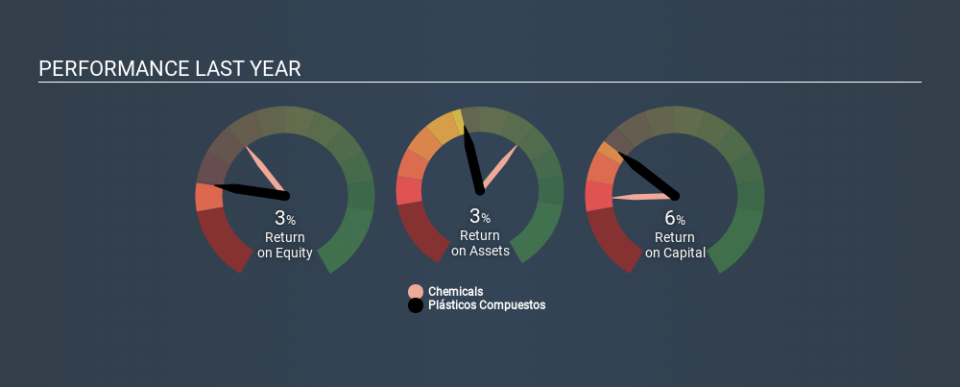Why Plásticos Compuestos, S.A.’s (BME:KOM) Return On Capital Employed Looks Uninspiring

Today we'll evaluate Plásticos Compuestos, S.A. (BME:KOM) to determine whether it could have potential as an investment idea. Specifically, we're going to calculate its Return On Capital Employed (ROCE), in the hopes of getting some insight into the business.
First, we'll go over how we calculate ROCE. Then we'll compare its ROCE to similar companies. Finally, we'll look at how its current liabilities affect its ROCE.
Return On Capital Employed (ROCE): What is it?
ROCE measures the 'return' (pre-tax profit) a company generates from capital employed in its business. In general, businesses with a higher ROCE are usually better quality. Overall, it is a valuable metric that has its flaws. Author Edwin Whiting says to be careful when comparing the ROCE of different businesses, since 'No two businesses are exactly alike.
How Do You Calculate Return On Capital Employed?
Analysts use this formula to calculate return on capital employed:
Return on Capital Employed = Earnings Before Interest and Tax (EBIT) ÷ (Total Assets - Current Liabilities)
Or for Plásticos Compuestos:
0.057 = €1.3m ÷ (€39m - €17m) (Based on the trailing twelve months to June 2019.)
So, Plásticos Compuestos has an ROCE of 5.7%.
View our latest analysis for Plásticos Compuestos
Is Plásticos Compuestos's ROCE Good?
When making comparisons between similar businesses, investors may find ROCE useful. In this analysis, Plásticos Compuestos's ROCE appears meaningfully below the 8.8% average reported by the Chemicals industry. This could be seen as a negative, as it suggests some competitors may be employing their capital more efficiently. Separate from how Plásticos Compuestos stacks up against its industry, its ROCE in absolute terms is mediocre; relative to the returns on government bonds. It is possible that there are more rewarding investments out there.
We can see that, Plásticos Compuestos currently has an ROCE of 5.7% compared to its ROCE 3 years ago, which was 1.0%. This makes us wonder if the company is improving. You can see in the image below how Plásticos Compuestos's ROCE compares to its industry. Click to see more on past growth.
Remember that this metric is backwards looking - it shows what has happened in the past, and does not accurately predict the future. ROCE can be misleading for companies in cyclical industries, with returns looking impressive during the boom times, but very weak during the busts. ROCE is only a point-in-time measure. What happens in the future is pretty important for investors, so we have prepared a free report on analyst forecasts for Plásticos Compuestos.
How Plásticos Compuestos's Current Liabilities Impact Its ROCE
Short term (or current) liabilities, are things like supplier invoices, overdrafts, or tax bills that need to be paid within 12 months. The ROCE equation subtracts current liabilities from capital employed, so a company with a lot of current liabilities appears to have less capital employed, and a higher ROCE than otherwise. To counter this, investors can check if a company has high current liabilities relative to total assets.
Plásticos Compuestos has total assets of €39m and current liabilities of €17m. Therefore its current liabilities are equivalent to approximately 44% of its total assets. Plásticos Compuestos has a medium level of current liabilities, which would boost its ROCE somewhat.
What We Can Learn From Plásticos Compuestos's ROCE
Despite this, its ROCE is still mediocre, and you may find more appealing investments elsewhere. Of course, you might also be able to find a better stock than Plásticos Compuestos. So you may wish to see this free collection of other companies that have grown earnings strongly.
For those who like to find winning investments this free list of growing companies with recent insider purchasing, could be just the ticket.
If you spot an error that warrants correction, please contact the editor at editorial-team@simplywallst.com. This article by Simply Wall St is general in nature. It does not constitute a recommendation to buy or sell any stock, and does not take account of your objectives, or your financial situation. Simply Wall St has no position in the stocks mentioned.
We aim to bring you long-term focused research analysis driven by fundamental data. Note that our analysis may not factor in the latest price-sensitive company announcements or qualitative material. Thank you for reading.



